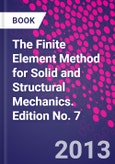The Finite Element Method for Solid and Structural Mechanics is the key text and reference for engineers, researchers and senior students dealing with the analysis and modeling of structures, from large civil engineering projects such as dams to aircraft structures and small engineered components.
This edition brings a thorough update and rearrangement of the book's content, including new chapters on:
- Material constitution using representative volume elements - Differential geometry and calculus on manifolds - Background mathematics and linear shell theory
Focusing on the core knowledge, mathematical and analytical tools needed for successful structural analysis and modeling, The Finite Element Method for Solid and Structural Mechanics is the authoritative resource of choice for graduate level students, researchers and professional engineers.
Please Note: This is an On Demand product, delivery may take up to 11 working days after payment has been received.
This edition brings a thorough update and rearrangement of the book's content, including new chapters on:
- Material constitution using representative volume elements - Differential geometry and calculus on manifolds - Background mathematics and linear shell theory
Focusing on the core knowledge, mathematical and analytical tools needed for successful structural analysis and modeling, The Finite Element Method for Solid and Structural Mechanics is the authoritative resource of choice for graduate level students, researchers and professional engineers.
Please Note: This is an On Demand product, delivery may take up to 11 working days after payment has been received.








